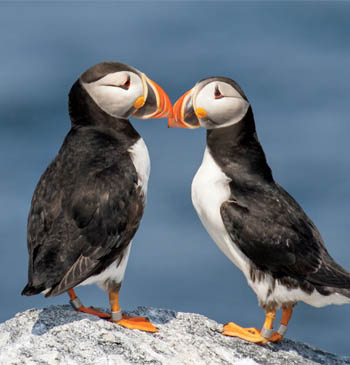
Audubon Adventures
Seabirds: Feathered Ocean Mariners

Activities
 Activity 3
Activity 3
What Keeps Seabirds Frost Free?

 Teacher-led Classroom Activity
Teacher-led Classroom Activity
Science/Research Skills/Inquiry/Math
How do penguins, puffins, albatrosses, and other seabirds stay warm in Arctic and Antarctic waters?
 Objective:
Objective:
Students test the ability of fat as an insulator to hold in heat in cold water.
Students will need:
- Shortening, lard, margarine, or other soft cooking fat
- Zipper-closing plastic freezer bags, quart-size
- Duct, packing, or other strong tape
- Tubs or large bowls (or a sink)
- Measuring cup and rubber spatula
- Water
- Ice
- Pencils
- Stopwatches or clocks with second hands
- Copies of the “What Keeps Seabirds Frost Free?” experiment reproducible
Suggested time:
One class period
What to do:
- Assemble one insulated mitt for each pair or small group of students. First scoop enough of the soft fat (1/2 to 1 cup) into a zipper-closing freezer bag and move the fat around so that it coats all of the inner surfaces of the bag. Try to keep the zipper closing free of the fat. Turn another freezer bag inside out and put it inside the fat-filled one. Since the inner bag is inside-out, you are able to zip the closings of the two bags together so they are attached to each other. This leaves the inner bag open so that a hand can be placed inside. Add duct tape or other tape to the seals to prevent water from entering.
- Make an equal number of empty (uninsulated) mitts. Place one inside-out freezer bag into another and zip and tape them together.
- Distribute copies of the “What Keeps Seabirds Frost Free?” reproducible, one for each student. Give an overview of the experiment: Students will test how well each of the “mitts”—one insulated with fat and the other uninsulated—protects their hands from cold water. Go over the Think & Predict section of the reproducible and have students write their predictions.
- Fill individual tubs or the sink with water and ice. If you feel it’s necessary, demonstrate how to use the two different mitts.
- Divide students into pairs or small groups. Have them follow the instructions on their reproducibles. Make sure they have access to a clock with a second hand or a stopwatch. Ask them to take turns using the “mitts” and recording their findings.
- Once everyone has had a chance to perform the experiment and record the data, ask each pair or small group to report on their findings.
- With the whole class, come up with a statement that summarizes the experimental findings about fat as an insulator.
Photos: Jean Hall




